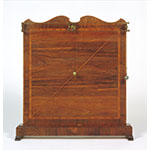The apparatus shows the effects of the composition of a horizontal motion and a vertical motion, a concept that lies at the heart of the Galilean theory of motion. A wooden base holds a vertical panel whose top carries two horizontal rails formed by a pair of metal wires. A small brass trolley can be pulled horizontally along the rails by means of a cord holding a weight and passing over a pulley. A second cord, also carrying a weight, is fastened to one end of the rails and passes over a pulley attached to the trolley. When the trolley is pulled, the shift in the pulley joined to it causes the weight to rise along the diagonal. This illustrates the fact that the composition of two perpendicular motions produces a diagonal path. The latter is also materialized by a groove of pale wood on the vertical panel. In Leçons de physique expérimentale (Paris, 1743-1748), Jean-Antoine Nollet described a similar instrument in which the trajectory resulting from the combination of the two perpendicular motions was plotted by a pencil on the panel. Provenance: Lorraine collections.










